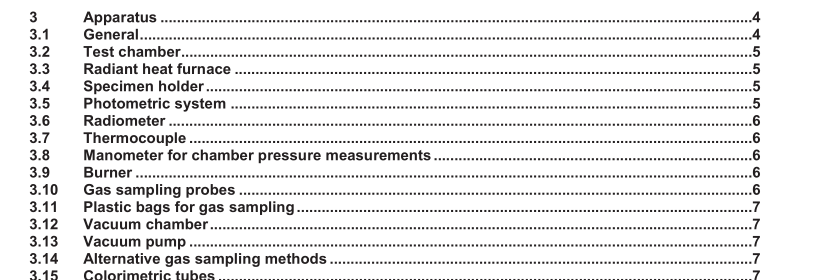EN 2824:2011 – Aerospace series – Burning behaviour of non-metallic materials under the influence of radiating heat and flames – Determination of smoke density and gas components in the smoke of materials – Test equipment apparatus and media

3.2 Test chamber See Figure 1. The test chamber shall be designed to provide inside dimensions of (914 × 610 × 914) mm ± 3 mm for width, depth, and height respectively. The interior surfaces shall consist of porcelain-enamelled metal or equivalent coated metal resistant to chemical attack and corrosion, and suitable for cleaning. Panels of 10 mm thickness of porcelain-enamelled steel (interior surface) laminated to a heat-resistant core and backed with corrosion- resistant steel (exterior surface) have been found suitable. Sealed windows shall be provided to accomodate a vertical photometric system. All other chamber penetrations shall also be sealed. When all openings are closed, the chamber shall be capable of developing and maintaining positive pressure during the test period. In order to avoid an excessive increase of pressure in the chamber during testing an airtight safety disc is required, e. g. a sheet of aluminium foil of thickness not greater than 0,04 mm and a minimum area of 800 cm 2 shall be provided in an opening of the chamber floor.
3.3 Radiant heat furnace See Figure 2. The furnace shall be located according to Figure 3 equidistant from the front and back of the test chamber. The furnace control system shall maintain the required irradiance level of (25,0 ± 0,5) kW/m 2 on the specimen surface for 20 min under steady-state conditions with the chamber door closed (to be demonstrated in calibration). The control system shall consist of a variable transformer or an equivalent control device, and a voltmeter or other means for monitoring the electrical input. Where line voltage fluctuations exceed ± 2,5 %, a constant-voltage transformer is required to maintain the prescribed irradiance level.
3.4 Specimen holder Stops have to be provided to center the specimen accurately in front of the furnace. Figure 4 shows the construction of the holder. Two wires have to be placed in front of the specimen.
3.5 Photometric system
3.5.1 The photometric system shall conform to Figure 5. The light path shall be oriented vertically to reduce influences resulting from stratification of the smoke generated by materials under test. The system shall conform to 3.5.2 to 3.5.4.
3.5.2 The light source shall be a 6 V incandescent lamp, operated at a fixed voltage to provide a brightness temperature of (2 200 ± 100) K. The light source shall be located in a sealed and light-tight box. This box shall contain the necessary optics to provide a collimated light beam of about 50 mm diameter passing vertically through the chamber.
3.5.3 A photomultiplier with a spectral sensitivity rating of S-4 and a dark current of less than 10 -9 A shall be used. For amplification, a multirange amplifier shall be used, suitable to measure continuously the relative light intensity in percentage transmission over at least five orders of magnitude. The system shall have a linear response with respect to transmittance and an accuracy of ± 3 % of the maximum reading on any range. A set of nine gelatin compensating filters varying from 0,1 to 0,9 neutral density is mounted in a number of one or more as required in the optical measuring system to provide for correction of light source or photomultiplier aging and reduction in light transmission through discoloured or abraded optical windows. A light-tight box located directly opposite the light source shall be provided to mount the photodetector housing and the associated optics. A glass window shall be used to isolate the photodetector and its optics from the chamber atmosphere.
EN 2824:2011 – Aerospace series – Burning behaviour of non-metallic materials under the influence of radiating heat and flames – Determination of smoke density and gas components in the smoke of materials – Test equipment apparatus and media